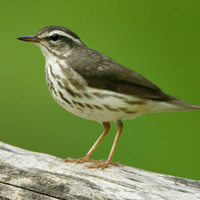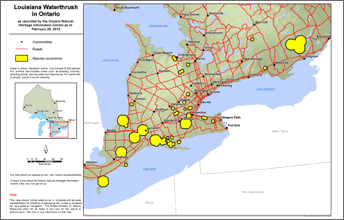Louisiana waterthrush
Scientific name: Parkesia motacilla

Cover photo credit: Brian E. Small
Status
Threatened
“Threatened” means the species lives in the wild in Ontario, is not endangered, but is likely to become endangered if steps are not taken to address factors threatening it
Date added to the Species at Risk in Ontario List
The Louisiana Waterthrush was already assessed as a species of special concern when the Endangered Species Act took effect in 2008. The species was reassessed as threatened in June 2016.
Read the assessment report (PDF)
What it looks like
The Louisiana waterthrush is a relatively large member of the wood warbler family. Males and females are identical in appearance. The upper parts are dull brown, and lower parts are cream-coloured with dark streaks on the breast and flanks. The bill is long and heavy for a warbler and the face is distinguished by a prominent white eye stripe. When it walks, this bird flicks its tail in a bobbing motion.
Where it lives
The Louisiana waterthrush is usually found in steep, forested ravines with fast-flowing streams. Although it prefers running water, especially clear, coldwater streams, it also less frequently inhabits heavily wooded, deciduous swamps having large pools of open water. It nests among the roots of fallen trees, in niches of stream banks, and in or under mossy logs.
Where it’s been found in Ontario
The Louisiana waterthrush summer range extends from the lower Great Lakes south to Georgia and west to Kansas. Its winter range, though poorly known, includes much of Mexico, the Caribbean, Central America, and extreme northwestern South America.
In Canada, the Louisiana waterthrush breeds only in southern Ontario, along the Niagara Escarpment, in woodlands along Lake Erie and scattered locations elsewhere. It probably nests sporadically in southwestern Quebec, but breeding there has never been confirmed.
The Canadian breeding population is estimated to be between 105 and 195 pairs, which represents less than one per cent of the total continental population. Although the species has declined locally in some parts of its breeding range, due to habitat loss and degradation, overall population levels have been relatively stable in both Canada and much of the United States over the past 20 years.
View a larger version of this map (PDF)
What threatens it
The Louisiana waterthrush is at the northern limits of its range in Ontario and was likely never common here. Local declines have occurred as forests were cleared and wetlands drained, particularly in southwestern Ontario. Although able to tolerate moderate levels of direct human disturbance, this species has specialized habitat requirements that make it particularly susceptible to deforestation, loss of canopy cover, fluctuating water levels, water pollution and siltation.
Action we are taking
Threatened species and their general habitat are automatically protected.
What you can do
Report a sighting
- Report a sighting of an endangered animal or plant to the Natural Heritage Information Centre. Photographs with specific locations or mapping coordinates are always helpful.
- Bird Studies Canada is working to advance the understanding, appreciation and conservation of wild birds and their habitat in Ontario and elsewhere; for more information on how you can help, visit: www.bsc-eoc.org
Volunteer
Volunteer with your local nature club or provincial park to participate in surveys or stewardship work focused on species at risk.
Be a good steward
Private land owners have a very important role to play in species recovery. You may be eligible for stewardship programs that support the protection and recovery of species at risk and their habitats.
Report illegal activity
Report any illegal activity related to plants and wildlife to
Quick facts
- the Louisiana waterthrush is among the earliest long-distance migrating birds to arrive back to Canada in the spring, typically arriving by mid-April
- the female lays from four to six eggs and incubation takes from 12 to 14 days; both parents feed the young, which remain in the nest for about 10 days
- the Louisiana waterthrush has a specialized diet and feeds mostly on aquatic and flying insects; it sometimes also feeds on small molluscs, fish, crustaceans, and amphibians
